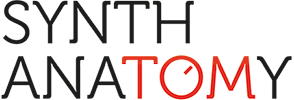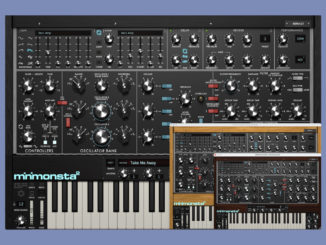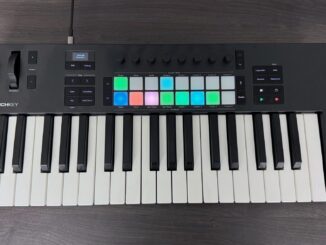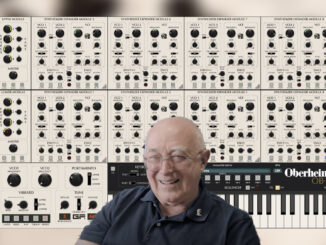GForce Novation Bass Station review: authentic emulation of the original 1993 Bass Station Synthesizer with added polyphony, unison, and more
The British music tech company Novation was founded in 1992. One year later, they launched the Bass Station, its first analog Synthesizer, which quickly proved successful.
It had a powerful sound with a good layer of bottom end, could create Roland TB-303-like timbres, was versatile, and was affordable thanks to its all-plastic construction. The success was so great that more synths were built on this analog concept, including the Super Bass Station, Bass Station rack, and more.
Many years later, an in-house emulation followed. Since the plugin no longer received updates, Novation pulled it from downloads last year. But that is no reason to be sad.
Today, the Bass Station plugin returns with the help of another British company, GForce Software. GForce Novation Bass Station is the official successor to the original plugin. Spoiler alert: the plugin is free for users of the Launchkey Mk4, FLKey, and SL MK3 MIDI keyboards.
GForce Novation Bass Station Review
First, I have never owned a Bass Station I (1993), so I cannot judge how accurate the plugin is. Novation states in the press release that it is an exact emulation. Owners of the original hardware must decide whether this statement is true. Let’s now dive into the plugin.
Like the other GForce plugins, the download and installation procedure is straightforward. Once you have entered your serial and loaded it, the Bass Station adventure in the DAW begins. You can choose between two GUIs: one that mirrors the Bass Station hardware interface 1:1 and a bigger second that offers new features.
Analog-Modeled Engine
The GForce Novation Bass Station plugin uses an analog modeling engine that emulates the analog circuits of the hardware version. Regarding features, it’s not a 1:1 software replica. Yes, it has all the original features but also adds 16-voice polyphony, unison modes, and more. So, you have a polyphonic Bass Station synth.
Like the 1993 unit, it comes with two multi-wave oscillators, PWM, sync, 12dB/24dB filters, two envelopes, and a multi-wave LFO. The good news is that the Novation Bass Station plugin has more on offer. For example, oscillator 1 includes a sub-oscillator for more beefier sounds.
Also new is the built-in noise generator and the option to make FM between the OSC2 and the sub-oscillator. FM may not work at first. However, you must ensure that the oscillator mix in oscillator 1 also includes OSC2 (OSC mix middle position). That happened to me often on the first day.
The possibility of working with FM makes a lot of sense here and unlocks more timbres with much more harmonic complex structures—especially more experimental and noisy sounds.
The emulation also includes the oscillator modulation section, which was extensive then. It lets you modulate each oscillator individually with an envelope or LFO and create pulse-width modulation (PWM).
The signal then flows into a recreation of the original analog filter with switchable 12dB/oct and 24dB/oct slopes. Classic cutoff and resonance controls can be tweaked, and an LFO or envelope (2) can automate them. Interestingly, the 12dB/oct can’t self-oscillate at high-resonance settings.
The GForce Novation Bass Station plugin includes keyboard tracking for the 24dB/slope, though it wasn’t available in the hardware. The filter is very characteristic. It can be gentle and tame but also wild. At high resonance, it screams beautifully and overdrives the sound beautifully.
In combination with the built-in sequencer and enough resonance, it comes very close to the Roland TB-303 behavior. One step further, we get our two modeled ADSR envelopes with velocity controls.
Advanced Modulation + Multi-FX
Behind the oscilloscope is a new panel with which you can route parameters to pitch-bend, mod wheel, velocity, and aftertouch in no time.
GForce has also given the plugin its unique one-click X modifiers, which supercharge the classic Novation Bass Station modulation with unlimited, advanced LFOs and ADSR envelopes. This massively expands the Bass Station sound spectrum and makes it more versatile than ever.
Assigning the modulation is a bit tricky. You have to right-click on the knob and move it up and down. This is particularly suboptimal when you’re on the go. A pop-up screen would be easier here.
Right next to it is a multi-FX processor with five all-time favorite GForce effects: a high-pass filter, multi-type distortion, chorus, delay, and reverb. These have the usual high quality and are well suited to refining, finalizing, or even taking sounds further into different sonic fields.
Indeed, the original Bass Station 1 did not have a high-pass filter. This also applies to the GForce Novation Bass Station plugin filter section. However, in the multi-FX section, you can find a resonating HPF with 12dB/oct and 24dB/oct slopes. It’s a great addition, allowing you to create some thinner sounds.
Remember that the multi-FX parameters can also be modulated with the X-Modifier. For example, click on the highpass frequency and increase the LFO amount, and the modulation is online.
Arpeggiator & Sequencer
We stay in the second half, where the virtual keyboard is located, but there is more to explore. GForce Novation Bass Station also features a playful arpeggiator and sequencer packed with creative features.
Okay, the arpeggiator is classic and has no unique key features: rate control, swing, octave, mode, and state. The sequencer is different; it is full of creative tools. It has 16 steps that can be programmed by clicking or playing them. That doesn’t sound like a lot, but small tools allow you to spice up these steps.
In addition to the note information, you can set per-step values for the accent, slide, probability, octave, and velocity. I would have liked ratcheting, but you can’t have everything. If you use the accent and slide, you can quickly get the vibe of a Roland TB-303.
A welcome feature is the built-in customizable random generator for the notes, note lengths, and velocity – a one-click source of inspiration for new patterns.
A second GUI hides even more sequencer fun. GForce Novation Bass Station has two freely assignable macro controls. You can automate both macros in two dedicated sequencer lanes, along with the option to tweak them manually—a simple but powerful feature to bring life to any sequence.
Like the sequencer, the automation sequencer has proper per-step values for the accent, slide, and probability. It also includes a randomizer for both macro lanes. It’s nothing revolutionary, but it’s a tool that can quickly create a new vibe from an existing sequence.
Factory Sounds
Sounds sounds sounds, the motto of this new GForce Synthesizer plugin. The new Bass Station VST features over 300 professionally designed factory sounds that cover a wide range, including arpeggiators, basses, effects, one-hits, keys, leads, pads, and more.
The sound designers have created a beautiful, harmonious mix that shows what the new Novation GForce Bass Station plugin can do.
There are softer sounds that can be wonderfully embedded in ambient soundscapes (Cave Crawling, Memories…) but also dirty, rosy acid lines that fit into techno tracks (Gritty Sequence, Dropping Doves…). Of course, juicy, fat basses with that extra bottom end are also available.
Not comparable are sounds that use the 16-voice polyphony that did not exist in the original hardware in this form. Patches like PolyWaveplex, PPG Keys, or Giants Fall make the engine appear in a different, unusual light. Timbres that you don’t know from the Bass Station make the plugin unique on its own.
As usual, the sounds are embedded in an easy-to-use sound browser organized into different sections: categories, types, timbres, and patches. Plus, you can audition sounds in a specific key right in the browser, random your selection, and highlight your favorites.
GForce Novation Bass Station Review Summary
Novation Bass Station is back, and you can say it loudly. GForce Software has managed to create a fantastic-sounding Synthesizer plugin that is multifaceted and full of character. Thanks to the new features (polyphony, more modulation, multi-FX…), sounds you would only dream of in the original Bass Station or even Bass Station 2 today are possible.
I can’t say how accurate the emulation is because I have never owned one. However, in the last few days, I have listened to many sound demos, including the video from AudioPilz, and I have found many sonic similarities.
Major criticism? No, really, but suggestions for the developers. On one side, there is always a recurring missing global X on/off switch. On the other, the somewhat cumbersome way of tweaking parameter modulation amounts. Not a fan of it mainly in mobile setups. Also, a mod matrix would be beneficial in better seeing all active modulations of a patch.
Overall, it’s a lovely synth plugin that captures the spirit of the original hardware. Compared to the first Novation Bass Station VST, the GForce version is miles better and more advanced—no wonder they have been 22 years apart.
If you use the recent Novation MIDI keyboards, the GForce Bass Station plugin is a no-brainer deal.
Availability
The GForce Novation Bass Station is available now for an introductory price of £49,99 + VAT until the end of February 2025 (reg. £99,99). Novation Launchkey Mk4, FLKey, and SL MK3 customers will get the plugin for free upon registering their products.
More information here: Novation / GForce Software











I owned one for many years and I can tell the emulation is quite accurate as far as my brain remembers
I have a bass station rack.i remember on one occasion having to quickly leave the room due to the acid bass line I had going almost emptying the contents of my stomach I doubt any emulation could do that.
Rad, port it to the circuit tracks as synths 3-4.